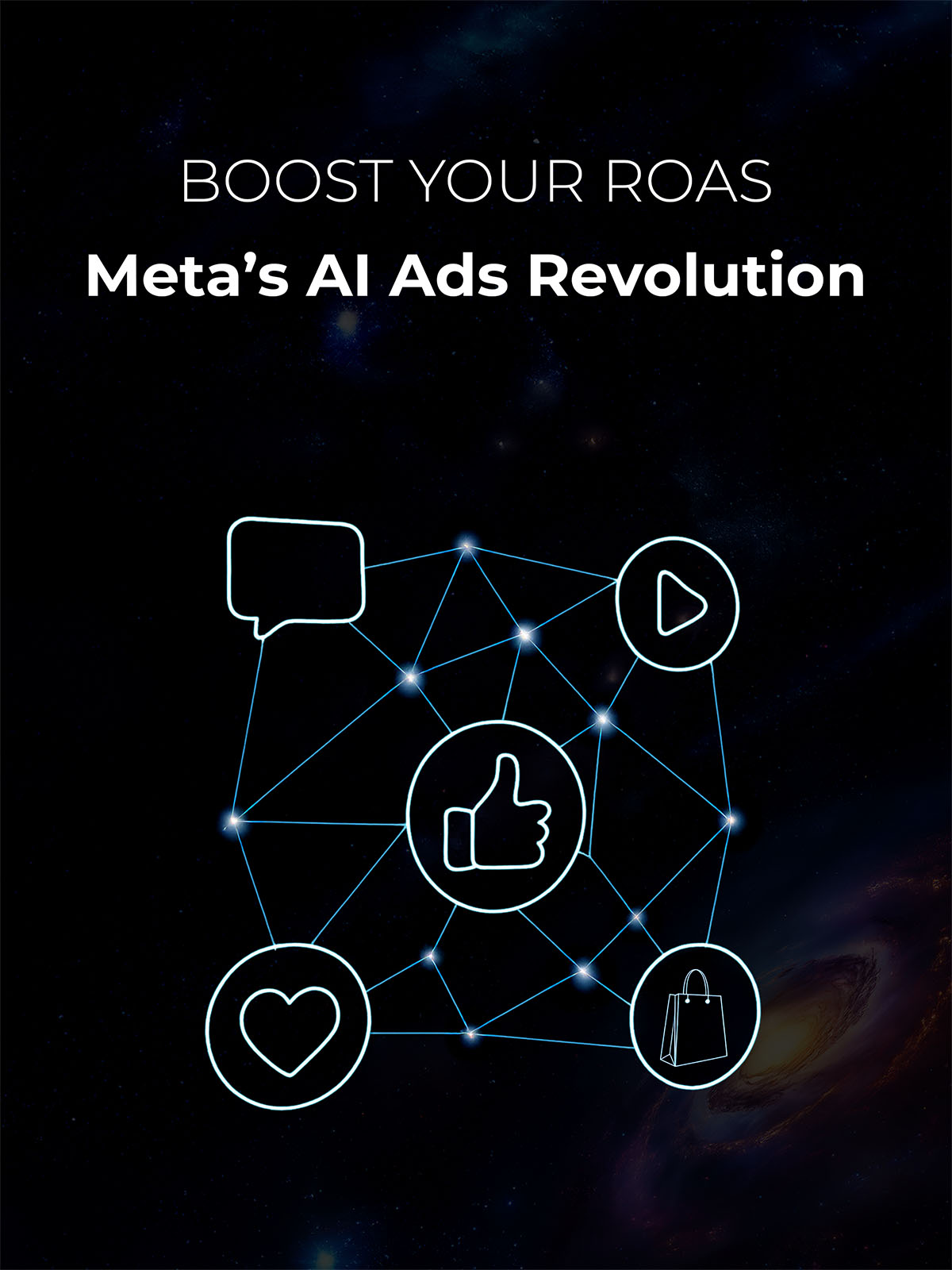Introduction
It’s happening: AI-powered advertising is no longer an experiment or emerging trend—it’s the new standard across platforms. Leading the charge is Meta, whose rollout of the Andromeda retrieval engine and its expanding Advantage+ suite is reshaping how brands, marketers, and e-commerce businesses build and scale ad campaigns across Facebook, Instagram, Messenger, and beyond.
Meta’s AI ads are unlocking unprecedented performance, with campaigns that automatically test dozens of creative variations, target customers with precision, and optimize spend in real time based on behavior and predicted outcomes. Early adopters are saving time while seeing significant increases in return on ad spend (ROAS), lower cost per acquisition (CPA), and the ability to scale winning campaigns with less friction than ever.
This shift comes at a pivotal time. Across the digital landscape, marketers are contending with reduced signal clarity due to privacy updates, rising creative production costs, and increasingly fragmented consumer journeys. Meta’s Advantage+ suite was introduced in direct response to this complexity—automating decisions that used to require entire teams of analysts and media buyers. In fact, Meta reports that advertisers using Advantage+ Shopping campaigns saw, on average, a 22% increase in ROAS compared to manual setups. That kind of lift, paired with the ability to generate high-performing ad creative instantly, is transforming digital advertising from a manual grind into a scalable, data-rich system that can adapt to rapid change.
In this post, we’ll explore what makes Meta’s Andromeda and Advantage+ so transformative, dig into how U.S.-based brands are applying these tools in real campaigns, examine how platforms like Google and TikTok are answering back, and offer a strategic lens on what marketers should watch for as AI becomes the backbone of digital advertising.
What Are Advantage+ and Meta Andromeda?
Advantage+
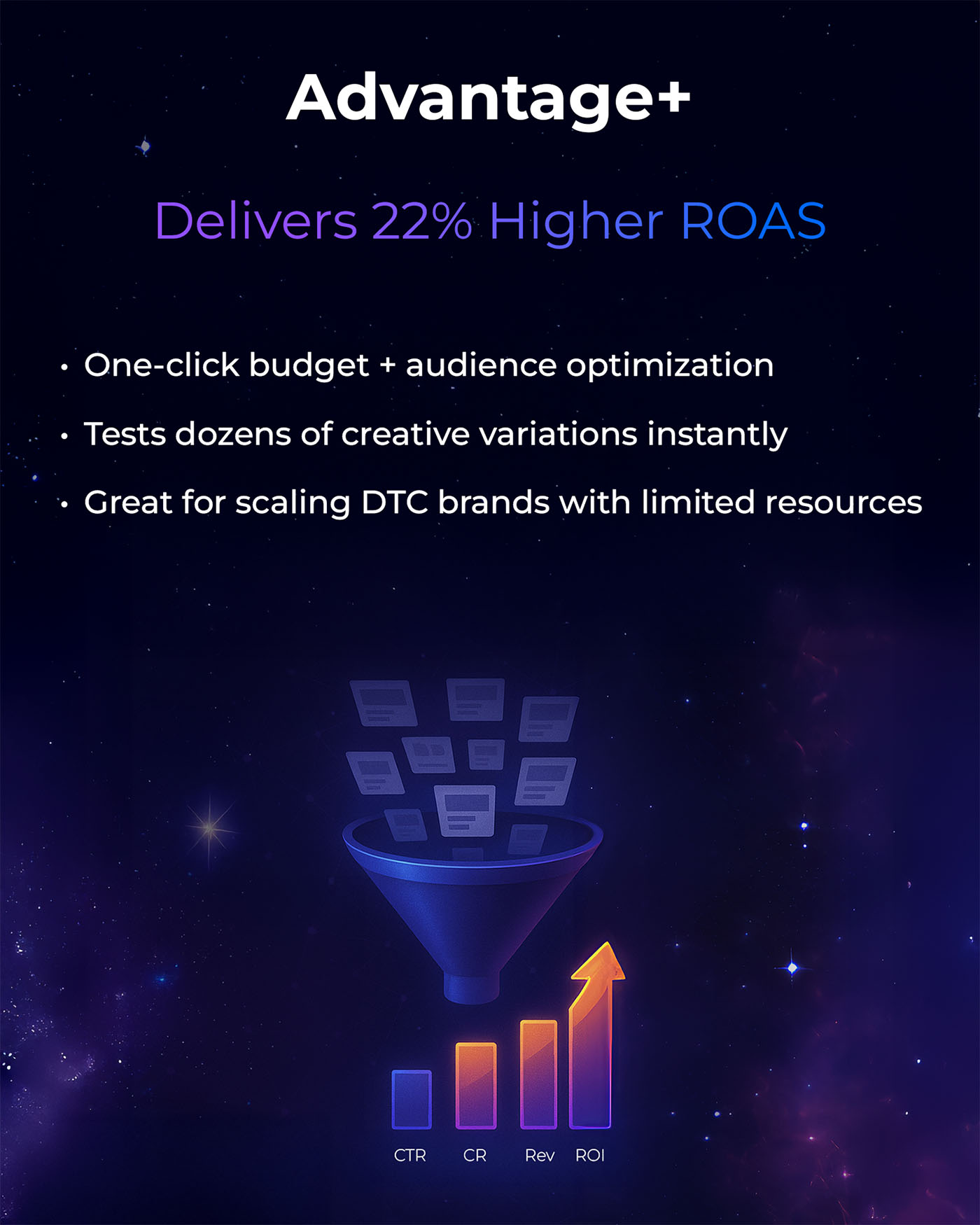
Introduced widely between 2022 and 2023, Advantage+ is Meta’s suite of AI-powered automation tools. They streamline campaign setup, audience targeting, budgeting, and creative testing. By eliminating many of the manual steps in Ads Manager, Advantage+ enables advertisers to scale faster and focus more energy on strategy and messaging. In a Meta-led study of 31 e-commerce advertisers, Advantage+ Shopping campaigns delivered an average of 32% higher ROAS compared to standard campaign setups.
Beyond these ad optimizations, many AI tools now power full purchase experiences directly within chat interfaces. Learn how with our deep‑dive into AI shopping assistants.
Meta Andromeda
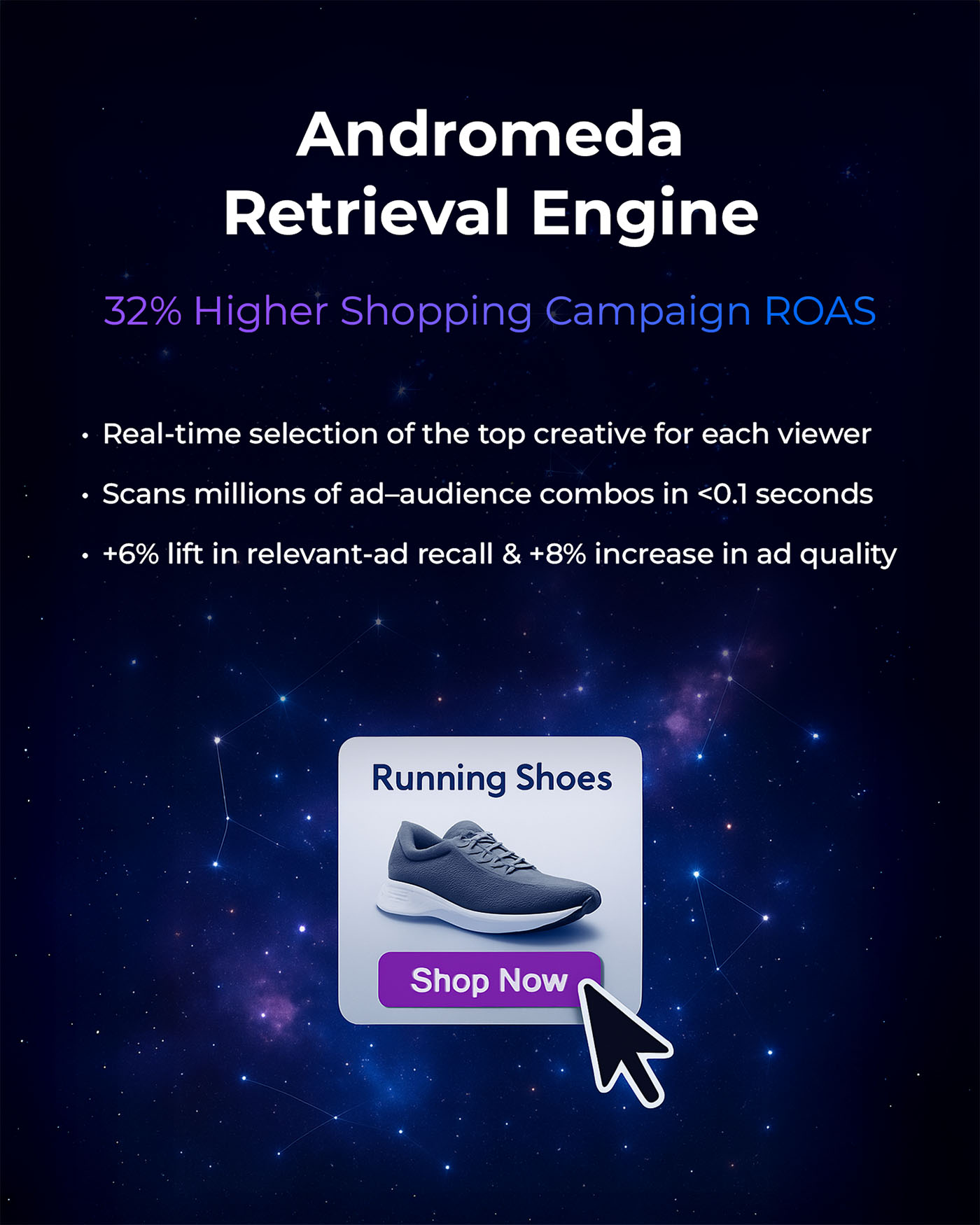
Rolled out in late 2023 and continually refined through 2025, Andromeda is Meta’s proprietary AI engine that powers ad retrieval, or the process of selecting which ad to show a user in real time. Running on custom infrastructure and deep learning models, Andromeda sifts through millions of ad candidates in milliseconds to match viewers with the most relevant content. The introduction of the Andromeda engine resulted in a 6% improvement in relevant ad recall and an 8% improvement in overall ad quality across Meta’s platforms. Industry leaders consider it a breakthrough: “This is the biggest shift in Meta ads since iOS14, and it’s already live,” wrote Common Thread Collective CEO Taylor Holiday.
Together, these two pillars—Andromeda for precision ad retrieval and Advantage+ for full-funnel automation—give advertisers a strategic edge at a time when signal loss and creative fatigue are major threats to performance. They’re not just new tools—they’re a new operating system for digital advertising.
Advantage+ Gets Smarter in 2025
In 2025, Advantage+ has evolved significantly, with three key advancements:
1. Enhanced Creative Generation
Brands can now input a single image or copy block and instantly generate dozens of variations—new visuals, alternate headlines, or different calls-to-action tailored for specific formats or audience segments. U.S. haircare brand Living Proof saw a 15% drop in cost per purchase and an 18% lift in total purchase volume after using Meta’s AI image and text generation tools within Advantage+ Shopping campaigns. They used the tool to generate 150 ad variants from just 5 base images. Cosmetics brand Fresh similarly reported a fivefold increase in ROAS and a 42% spike in purchases after testing AI-powered text variation during the 2023 holiday season.

2. Full-Funnel Acquisition Tools
Advantage+ Leads has matured into a full-funnel acquisition tool, with brands reporting up to a 10% improvement in cost per lead.
3. Dynamic Audience Targeting
Advantage+ Targeting dynamically adjusts who sees an ad based on real-time performance signals, often outperforming static interest-based targeting.
Impact on E-Commerce
Historically, successful digital advertising depended on large budgets and specialized teams capable of manual testing and optimization at scale, but Advantage+ and Andromeda have significantly leveled the playing field, making sophisticated campaign execution more accessible to more teams.
For emerging e-commerce brands, these tools have unlocked performance that might otherwise have required a dedicated media team. For instance, U.S.-based jewelry retailer Felicity leveraged Advantage+ Shopping during Cyber Week and saw a 24% increase in revenue alongside a 20% boost in customer repeat rate. By trusting Meta’s automation for campaign execution and targeting, Felicity tapped into profitable new customer segments with minimal manual effort.
Even established brands are seeing impressive results. Ben & Jerry’s used Meta’s AI-powered background generation within Advantage+ Catalog ads, creating fresh backgrounds for their product imagery. They achieved a 7% lift in ad link clicks, directly boosting online ice cream delivery sales. The takeaway: even incremental enhancements in creative—achieved at scale through AI—can drive measurable gains in campaign performance.

Another standout example is Jones Road Beauty, a direct-to-consumer makeup brand. During the 2024 holiday season, the team leaned heavily on Advantage+ Shopping campaigns. Rather than manually tweaking bids and audiences, they devoted their efforts to producing strong creative assets, trusting the AI to optimize placement and spend. According to CMO Cody Plofker, generative AI tools are enabling marketers to “produce and create more creative assets in less time,” freeing teams to focus on what they do best: strategy, storytelling, and brand-building.
However, the rollout of Meta’s AI ads has not been without its kinks. In a cautionary tale from February 2024, RC Williams, co-founder of marketing agency 1-800-D2C, experienced what many advertisers now call the “Valentine’s Day Disaster.” Meta’s Advantage+ system inexplicably blew through approximately 75% of the daily ad budgets for two of his clients in just a couple of hours. What made this particularly alarming was the CPM (cost per thousand impressions) inflation – jumping from a typical sub-$28 figure to roughly $250 – a 10x increase – while generating almost no revenue. Meta eventually acknowledged a platform bug, but only after numerous advertiser complaints and after significant damage had been done.
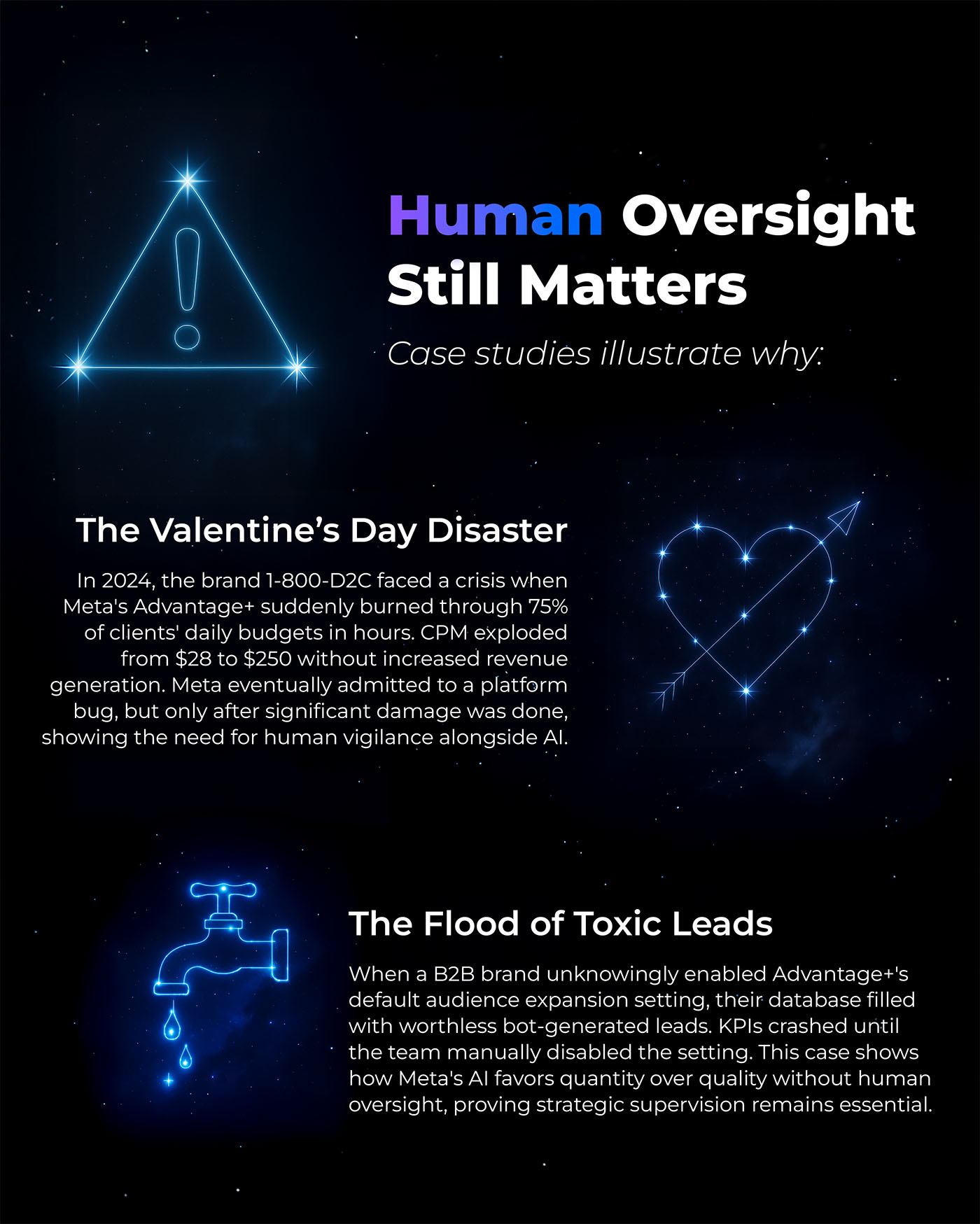
Google and TikTok Join the AI Arms Race
While Meta’s Advantage+ and Andromeda have dominated recent headlines, other platforms are equally invested in AI-driven advertising. Understanding how Google and TikTok are responding is critical for any brand looking to maximize its marketing mix.
Google Performance Max (PMax)
- Dominates e-commerce ad spend, capturing 82% of retail Google Ads investment.
- Boasts features like customer lifecycle bidding, negative keyword controls, brand safety measures, and automated image enhancements.
- Advertisers using PMax report 5.1× incremental ROAS and 2.2× higher purchase lift versus manual campaigns.
- Noteworthy Update: Brands can now set new customer acquisition goals and apply negative keywords for more precise targeting.
PMax is especially appealing for e-commerce brands with extensive product catalogs on Google Shopping. Its automated approach to bidding and placements across Search, Display, YouTube, and more parallels Meta’s Advantage+—but within the Google ecosystem.
While PMax has shown impressive results for many retailers, it also demonstrates why human oversight remains critical across all AI ad platforms. A Midwest bakery chain using Google PMax without location-specific keywords inadvertently targeted users 200+ miles away, wasting 22% of its budget on customers who would never visit their stores. Only after their marketing experts restricted the AI’s geo-targeting parameters and added negative keywords did the campaign’s CPA return to target levels. This example serves as an important reminder that whether using Meta or Google’s AI solutions, human attention remains essential.
TikTok Smart+
- TikTok’s answer to Meta Advantage+ and Google PMax, automating targeting, bidding, and creative.
- Early data shows ~5× higher ROAS and over 2× higher purchase lift compared to manually managed campaigns.
- Supports website conversions, app installs, lead generation, and catalog sales, including integrations with TikTok Shop.
Beyond short-form video, TikTok is aggressively expanding its social commerce features, making Smart+ an enticing solution for brands aiming to reach younger demographics and spark viral engagement.
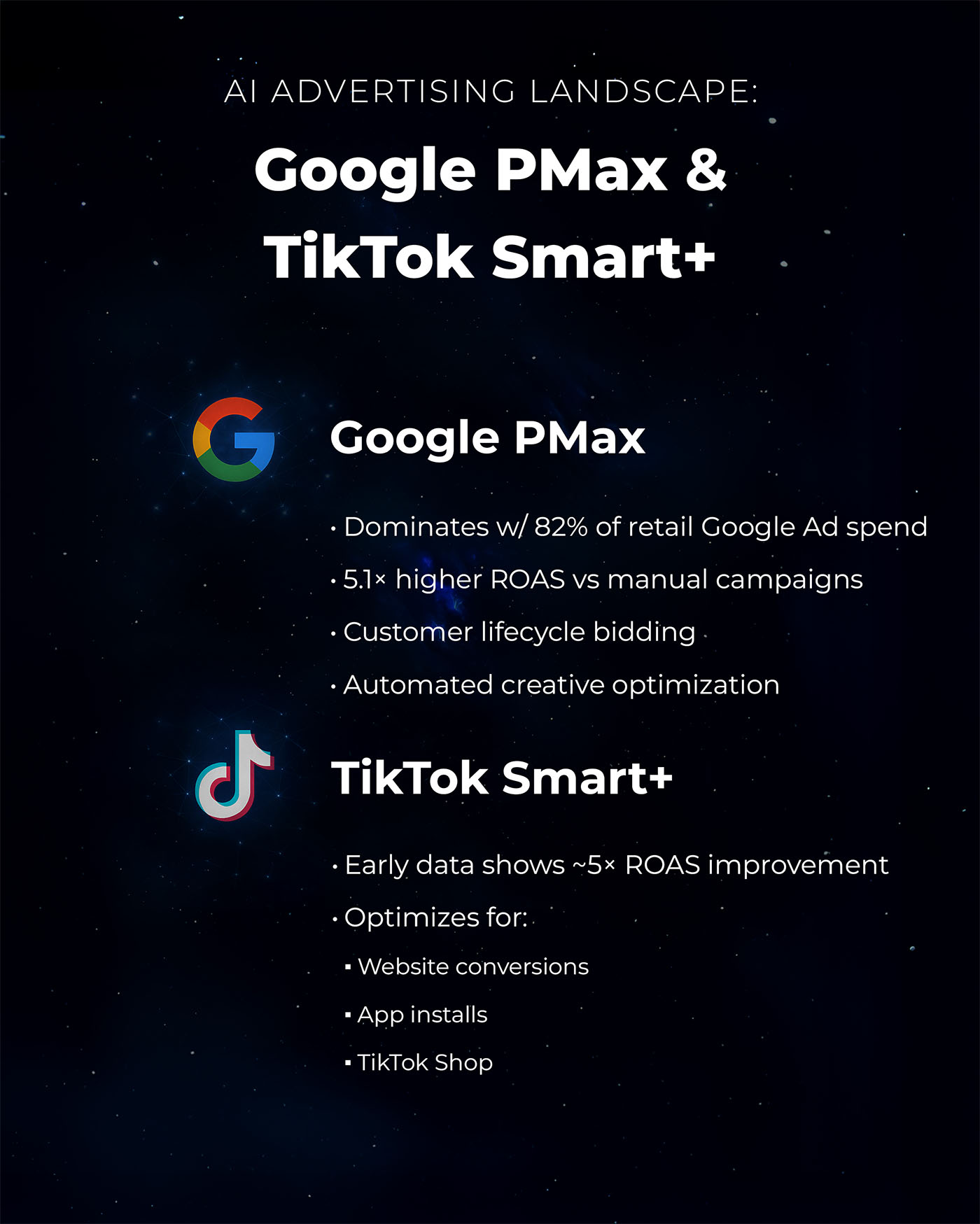
One telling indicator of this cross-platform reality:
Even Google has begun advertising its own products (like Pixel phones) on Facebook and Instagram.
AI Ads: Challenges & Strategic Considerations
Let’s examine both the limitations of AI-powered advertising tools and the strategic approaches to address them:
Algorithmic Bias and Content Homogenization
AI systems in advertising rely on historical data, which can perpetuate biases if not carefully audited. Salesforce notes that AI algorithms may inadvertently reinforce stereotypes when targeting demographics, leading to brand safety risks. Members of the Forbes Communications Council emphasize that over-reliance on generative AI risks homogenizing content and eroding brand differentiation. A 2024 study found that 37% of consumers perceived AI-generated ads as “generic,” highlighting the tension between scalability and authenticity.
Over-Automation and Strategic Blind Spots
While automation improves efficiency, BuzzBoard warns that excessive dependence on AI can reduce human oversight, resulting in campaigns misaligned with long-term brand equity. For example, brands using fully automated bidding strategies without periodic reviews often miss niche audience segments, as AI prioritizes short-term metrics like click-through rates over customer lifetime value. Datafeedwatch further notes that 42% of advertisers using AI-driven programmatic platforms reported unintended ad placements in non-brand-safe environments due to opaque targeting logic.
These issues are compounded by what one could call the “forced automation trap.” Meta has shifted from politely recommending Advantage+ to essentially forcing adoption through default settings. Creating campaigns the traditional way now requires advertisers to deliberately turn off multiple AI features that are automatically enabled with each new campaign creation. These include audience expansion settings and creative optimizations that many professional marketers would prefer to control manually.
A troubling example of these default settings causing harm comes from a B2B client running sales demo ads. After an audience expansion setting was accidentally enabled on a new Advantage+ ad set (a setting that’s now enabled by default), their database was flooded with junk leads within a week, many of which appeared to be bot-generated. When this setting was removed, lead quality immediately returned to normal levels. This case demonstrates how Meta’s AI optimization can sometimes prioritize volume metrics over quality.
Data Quality and Signal Loss
Privacy regulations like GDPR and CCPA have reduced access to third-party cookies, forcing AI systems to rely on modeled data. Incomplete datasets can lead to inaccurate predictions, particularly for local businesses with limited first-party data. A 2025 survey revealed that 58% of small e-commerce brands struggled to achieve ROAS targets with Meta’s Advantage+ due to insufficient customer behavior data.
Navigating the AI Ad Ecosystem: Strategic Tradeoffs
As AI-driven solutions like Advantage+, PMax, and TikTok Smart+ become the norm, marketers face a critical balance between automated optimization and strategic oversight. Key considerations include:
1. Black-Box Targeting and Performance Visibility
Platforms increasingly offer high-level reporting, but advertisers can struggle to see the granular “why” behind performance. This opacity can lead to questions about brand safety, audience overlap, and wasted spend.
2. Brand Consistency and Creative Direction
While AI excels at testing and iterating creative, humans must define brand guidelines, tone of voice, and overarching campaign themes. Ensure that auto-generated variations remain on-brand and resonate with core audiences.
3. Data Quality and Privacy
According to Lumenalta, key regulations impacting AI advertising include:
- GDPR (EU): Requires explicit consent for data collection and grants users deletion rights.
- CCPA/CPRA (California): Mandates transparency in data usage and opt-out mechanisms for data sales.
- Digital Markets Act (EU): Restricts large platforms like Meta from privileging their own services in ad auctions.
Meta’s Andromeda engine addresses these requirements by using on-device processing to anonymize user data, though its reliance on probabilistic modeling remains controversial.
Contextual advertising has emerged as a compliant alternative to behavioral targeting. Silverpush reports that 74% of marketers now use contextual data to align ads with webpage content, reducing reliance on personal data. For example, Ben & Jerry’s 2024 campaign using TikTok’s Smart+ contextual tool saw a 12% higher engagement rate than traditional demographic-based ads.
4. Strategic Human Input
Leaning too heavily on automation may yield short-term results but limit long-term brand equity. Teams should regularly review AI-driven ad sets, refining audience definitions and creative direction to align with bigger-picture goals.
5. Budget Allocation Across Platforms
Each AI-driven platform has its advantages and limitations—Google for high-intent search, Meta for broad social discovery, and TikTok for viral community engagement. Smart brands conduct cross-platform testing and shift budgets dynamically based on results.
A 2025 brand case study allocated 50% of budgets to Meta, 30% to PMax, and 20% to TikTok, achieving a 27% higher ROAS than single-platform strategies.
6. Creative Production Efficiency
Shopify‘s analysis highlights that AI tools like DALL-E reduce image production costs by 60%, but human oversight remains critical to maintain brand consistency. For instance, Fresh Cosmetics saved $220K annually using Meta’s AI-generated text variations but allocated 20% of those savings to human editors for quality control.
Implementing AI: Solutions and Best Practices
To maximize the benefits of AI advertising tools while minimizing risks, brands should consider these proven approaches:
Hybrid Human-AI Workflows
Kevin Roose argues that, rather than competing with machines on their terms (speed, data processing, repetition), humans should double down on their uniquely human skills: creativity, empathy, judgment, and collaboration. In this model, AI and automation handle the repetitive, data-driven, and scalable aspects of work. Meanwhile, humans focus on strategy, storytelling, ethical decision-making, and nuanced problem-solving. This partnership is not about ceding control to machines, but about creating workflows where AI augments human capabilities, leading to better outcomes than either could achieve alone.
“We should focus on being more human, and doing the kinds of creative, inspiring, and meaningful things even the most advanced AI can’t do,” notes Roose in Futureproof. This perspective is further validated by Stanford’s Human-Centered AI Institute, where Roose’s work was featured in a special event co-hosted by Stanford’s Digital Economy Lab and the McCoy Center for Ethics in Society, highlighting how organizations can thrive in the age of automation by leveraging this complementary relationship.
In practice, this approach is perfectly compatible with Meta’s AI advertising tools. For example, Jones Road Beauty’s 2024 holiday campaign combined Advantage+ automated targeting with in-house storytelling, achieving a 34% higher conversion rate than fully automated campaigns. This exemplifies Stanford HAI’s emphasis on human-machine partnerships that enable businesses to “focus on being more human” while leveraging AI for scalability and precision.
First-Party Data Enrichment
To mitigate signal loss, Geomotiv recommends integrating CRM systems with AI platforms. For example, Felicity Jewelry linked its Shopify customer database to Meta’s Advantage+ Catalog, improving audience matching accuracy by 40% and reducing CPA by 18%.
Cross-Platform Diversification
While Meta dominates social advertising, diversifying across Google PMax and TikTok Smart+ mitigates over-reliance on single algorithms.

Conclusion: Embracing the AI-Powered Ad Era
From Meta’s Advantage+ and Andromeda to Google’s Performance Max and TikTok’s Smart+, it’s clear that fully automated, AI-driven campaigns have become the backbone of digital advertising.
The most successful brands in 2025 and beyond aren’t those who passively let AI run their campaigns, nor those who cling to outdated manual processes. Instead, the organizations that will come out on top are those who truly collaborate with AI systems, mastering the balance between AI’s computational power and human creative/strategic vision.
As privacy regulations tighten and creative expectations rise, this balance becomes even more crucial. Brands must continually refine their first-party data strategies while developing distinctive creative approaches that prevent AI-generated content from becoming generic or indistinguishable.
At Envoli, we see these seismic shifts as opportunities for brands to reimagine paid media. While automation handles the complex optimization tasks, we help clients focus on what matters most: refining brand positioning, developing resonant storytelling, and creating high-quality content that stands out amid algorithmic uniformity. This synergistic approach ensures that technology serves strategy—not the other way around.
If you’re ready to fully leverage AI-driven advertising across platforms, we invite you to connect with us below.
Let's Talk Strategy.
Ready to launch a product, accelerate growth, or test a new idea for market demand? Let's talk.
